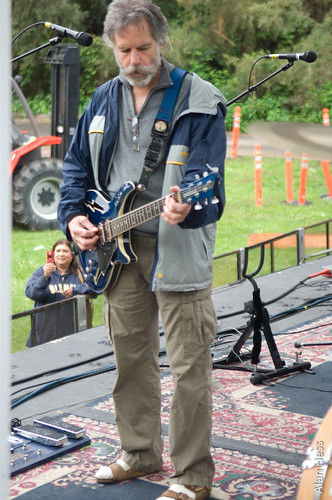Interesting article-
Grateful Dead Ahead of its time
Band served as an early model for branding
http://www.chicagotribune.com/entertainment/music/chi-tc-arts-the-dead-0422-0426_qapr26,0,3176704.story
Here's part of it:
Here's how the Dead anticipated the future we now live in during its 1965-95 life span:
Free music: The Dead was among the first bands to encourage its fans to tape its concerts and distribute tapes to their fellow Dead-heads worldwide. A specially designated "tapers section" was set up at each show near the sound board, and fans brought increasingly sophisticated gear to document nearly every one of the Dead's 2,000-plus concerts.
Make the product unique: Garcia expressed disdain for the recording studio countless times -- heresy in an era where the studio album became the centerpiece of music culture. Garcia insisted that live performance was the lifeblood of his band's music, and created a template for the jam-band culture. The Dead's studio recordings slowed to a trickle as the decades passed. Instead, the band focused on turning its shows into epic, four-hour must-see events for its followers. The Dead turned touring into an art form, a combination of high-tech ingenuity and grass-roots communication. The shows were infamous for their ups and downs, the possibility that the band could fail, but the sense of improvisation and spontaneity became an increasingly alluring alternative, especially in the highly choreographed MTV era. Fans paid to see multiple shows on the same tour, knowing that each would be one-of-a-kind.
Who needs record companies? Though the Dead worked with major labels throughout its career, the labels had very little to do with the band's inner workings. The Dead's operation was essentially self-contained, a network of friends and associates from the San Francisco area who assumed various jobs within what would become a highly successful corporation, Grateful Dead Productions. The band's mail-order service and later Web site, deadnet.com, became a gathering place for the Dead's worldwide fan base and sustained the band's legacy long after Garcia's death.
Sell direct to fans: The Dead released dozens of recordings from a bottomless stash of archives direct to fans, presaging the marketplace experiments of Radiohead and Nine Inch Nails. The Dead released only 13 studio albums in its 30-year lifetime. That relatively paltry number is dwarfed by dozens of live releases, including 36 volumes of the "Dick's Picks" archival series alone. The series was named after archivist Dick Latvala, who ascended from the ranks of the taper's section in the '70s to become one of the band's most trusted lieutenants. These releases, which were promoted only through the band's mail-order service and (later) Internet site, in many cases exceeded the quality of the band's major-label recordings.
The band as brand: The Dead dealt not just in T-shirts and hats, but in flip-flops and golf gloves. Frisbees, mugs, bar stools and license-plate frames. Key chains, a board game and socks. Magnets, patches and pins. Baby-clothes "onesies," hoodies and a miniature pyramid. The band also spawned a cottage industry of books, DVDs and even a syndicated radio show ("The Grateful Dead Hour"). The Dead became synonymous not just with a style of a music or a certain era, but also with a way of life that transcended generations.
Remix, remake, reinvent: Were the Dead the first modern rock band? Like all artists, the Dead borrowed freely from the music and traditions that preceded them. But a strong case could be made that no band worked with a wider palette or blended the colors more audaciously. By constantly reinventing itself through its music, the band remained relevant across the decades. Under the rubric of "American music," the Dead mixed blues, country, folk, early rock 'n' roll, jazz, experimental and even classical music into a fluid framework built not only on deep knowledge of the past but a mischievous desire to reshape it.
The band improvised its way through thousands of shows, and suggested that songs were not immutable artifacts, but organic entities that could be bent, folded and occasionally mutilated to suit the needs of the moment. In this respect, they anticipated the mix-and-match styles that would surface and flourish in the last few decades, from the cut-and-paste approach of hip-hop and collage artists such as Girl Talk, to the recombinant rock of Beck and the Flaming Lips. John Oswald's 1995 studio manipulation of multiple incarnations of the Dead's epic song "Dark Star" on the album "Grayfolded" is among the first widely recognized mash-ups.
1 day ago



